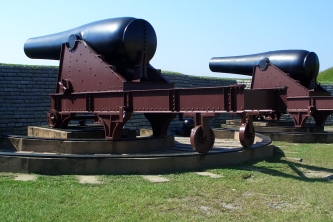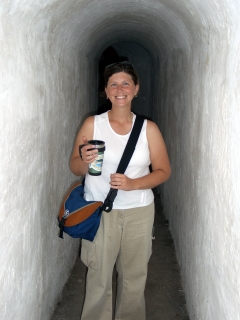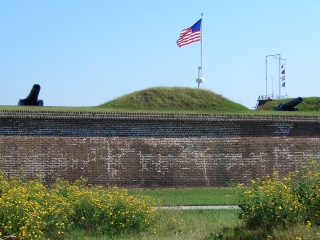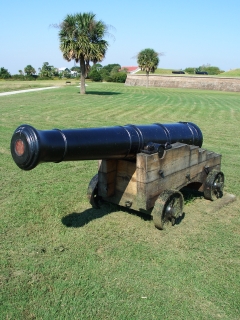NPS Website; Local Website
WHAT IS IT?
 Coastal defense fort that saw continuous military use for nearly two centuries, including major battles in both the Revolutionary and Civil Wars.
Coastal defense fort that saw continuous military use for nearly two centuries, including major battles in both the Revolutionary and Civil Wars.BEAUTY (6/10)
Red bricks replaced the namesakes of Fort Moultrie’s Palmetto Fort in the early 1800s. Low walls encircle a grass courtyard and a large unattractive black battery. It is hard to focus your eyes on the Fort’s interior when the Charleston Harbor and Fort Sumter create your horizon. Fort Moultrie NM offers a wonderful vantage point to view the busy waterway and skyline of the grand old city. Its flags, cannons and planted palmettos help frame the competing blues of the Harbor and the bright Carolina sky.
HISTORICAL INTEREST (6/10)
Confederate cannons fired the first shots of the Civil War from Fort Moultrie onto Fort Sumter. Nevertheless, Moultrie remains shrouded in a cloak of historical anonymity while Sumter is etched indelibly in our American consciousness.
Fort Moultrie was also site of a vital June 28, 1776 Revolutionary War battle which less than a week before our nation declared its independence from Great Britain. British Naval forces led by Commodore Peter Parker attempted to take the key city of Charleston but were repelled by forces commanded by Colonel William Moultrie.
 CROWDS (6/10)
CROWDS (6/10)We encountered a much larger crowd at Fort Moultrie than expected. Dozens moved in and out of the Fort’s quirky nooks and narrow passageways discovering the long history of a coastal fort.
EASE OF USE/ACCESS (3/5)
You need a car to get to Fort Moultrie NM, so if you have come to Charleston on a cruise ship, you are out of luck. The Fort is located on the west end of Sullivan’s Island at the narrowest entry point into Charleston Harbor.
From both downtown Charleston and Interstate 26, take U.S. Route 17 North. You will cross the dramatic Arthur Ravenel, Jr. Bridge. Once you reach the mainland take Coleman Blvd. (S.C. Route 703). Three miles later, Coleman Blvd. will bend and become Ben Sawyer Blvd but remain S.C. 703. You will be crossing marshlands on your way to the Island. Once you reach Sullivan’s Island, turn right onto Middle Street and take it to its end. You are there! Do not worry; there are plenty of signs.
CONCESSIONS/BOOKSTORE (4/5)
Fort Moultrie’s bookstore spreads itself thin across four wars and several ethnic and cultural topics. Books on the Gullah, Seminoles and the Underground Railroad sit next to stories, songbooks and cookbooks from the Civil and Revolutionary Wars, which share the shelves with a biography of the Swamp Fox, Secrets of a Civil War Submarine and a few paperbacks about the War of 1812 and the Spanish War.
While a few titles do stand out, like the Diary of a Common Soldier in the American Revolution, or Gardner’s Photographic Sketchbook of the Civil War, the store’s variety doesn’t allow for much depth in any of the subject areas. If Fort Moultrie’s bookstore were a basketball team, it would need a better sixth man.
COSTS (3/5)
 The Fort costs $3 per adult or $5 per family. If you have the National Parks Pass, entry is free.
The Fort costs $3 per adult or $5 per family. If you have the National Parks Pass, entry is free.RANGER/GUIDE TO TOURIST RATIO (3/5)
A charming septuagenarian South Carolinian examined our National Parks pass, shared some knowledge about Charleston’s unique architecture (“We were saved by our own poverty; people were too poor to knock down the old houses and build new.”) and alerted us to the next showing of the film. This was the most interaction we had with any Site staff. We vaguely recall a Ranger but this gentleman volunteer introduced us to the Site and directed us on our way.
It would have been nice to have a Ranger across the street at the actual Fort to answer questions as they arose.
TOURS/CLASSES (6/10)
Fort Moultrie’s Visitor Center houses a small set of exhibits, the bookstore and theatre where the Site’s introductory film plays every 30 minutes. What a film it is.
Filmed entirely on location, Fort Moultrie’s video is a one-man tour de force. An actor named Michael Longfield dons several period costumes, different facial hair variations and at least eight different accents to guide viewers through the history of the Palmetto Fort. The audience sees the Fort’s construction, two reconstructions and finally the closing of its gates as a military post through the eyes of a common soldier.
FUN (6/10)
We entered the Fort still smiling from Mr Longfield’s valiant linguistic efforts. Most of the Site is open for exploration. Several rooms within the battery are furnished as offices and radio control centers circa 1940, complete with pin-up calendars and board games to occupy bored privates.
There is a pathway circling the exterior of the Fort and leading down to a small beach. As appealing as this stroll sounds, do not exit the Fort without applying adequate amounts of bug spray. We were fine within the perimeter but mosquitoes swarmed as soon as we neared the water.
 WOULD WE RECOMMEND? (4/10)
WOULD WE RECOMMEND? (4/10)Fort Moultrie NM is one of the most military-focused units in the National Park System, a noteworthy distinction given the innumerable battlefields and war-related historic sites. Fort Moultrie spotlights the role of the soldier in every American conflict from the Revolutionary War to World War II as well as the soldier’s role in peacetime. We even recall a Park volunteer saluting paying customers.
The storied events of Fort Moultrie’s history are even downplayed in favor of highlighting the life of the average soldiers who fought there. Fort Moultrie soldier-centric learning experience contrasts sharply to the historical overview offered at its sister site Fort Sumter. In addition, the view offered at Moultrie is the closest you can get to Fort Sumter without taking the ferry. It worked for the Confederate cannons; it can work for you.
TOTAL 46/80
www.usa-c2c.com
© 2005